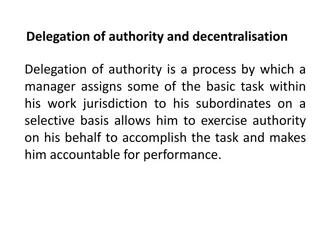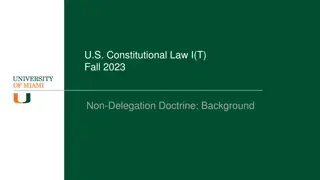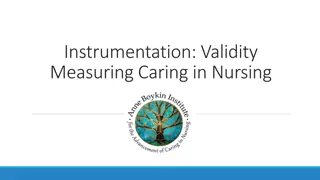Enhancing Nursing Delegation Through Technology: A Pilot Project
This presentation discusses the importance of delegation in nursing, introduces a pilot project involving a software-based delegation system, identifies the problem of lack of knowledge around RN delegation, outlines a change model, presents a PICO question on the impact of delegation tools on patient outcomes, and highlights the scope of the problem of inefficient delegation in nursing. The project aims to improve nurse workload understanding, optimize task delegation through algorithms, and ensure delegated work is carried out efficiently.
Download Presentation

Please find below an Image/Link to download the presentation.
The content on the website is provided AS IS for your information and personal use only. It may not be sold, licensed, or shared on other websites without obtaining consent from the author. Download presentation by click this link. If you encounter any issues during the download, it is possible that the publisher has removed the file from their server.
E N D
Presentation Transcript
The Importance of Delegation in Nursing Esther Reich Chamberlain College of Nursing NR451 RN Capstone Course 1stSemester: 2015
Measuring the Effectiveness of Nursing Delegation Systems: A Pilot Project
Agenda Introduction Timeline The Problem Nurses Roles and Responsibilities Description of Change Model Procedure PICO Question Resources Scope of the Problem Outcomes Team / Stakeholders Summary Evidence to Support Change References Action Plan
Introduction The pilot project will involve installing a software-based delegation system that gives nurses a means of: Understanding nurse workload. Automatically sending directives to nurses following up on work directives to ensure that delegated work is being carried out. Making use of algorithms to optimize task delegation.
The Problem The problem identified in Milestone 1 was the lack of knowledge around how best registered nurses (RNs) candelegate. RN delegation was identified as a means of performing work more efficiently, reducing errors and costs.
Change Model Johns Hopkins Evidence-Based Practice (EBP) Process Practice Question, Evidence, and Translation (PET) Practice Evidence Translation
PICO Question What impact would valid delegation tools, provided to nurses, have on their ability to safely delegate? P: RNs in a hospital setting. I: The use of valid delegation tools. C: Control group of RNs who do not use delegation tools. O: Improved patient outcomes.
Scope of the Problem Nursing delegation is between 50% and 80% efficient. (Maenhout & Vanhoucke, 2013). Inefficient delegation means a higher incidence of nursing errors and administrative costs, and lower nurse productivity. (Duffield, Gardner, & Catling-Paull, 2008; Meum, Wangensteen, Soleng, & Wynn, 2011; Potter, Deshields, & Kuhrik, 2010).
Team / Stakeholders The team will include the following 7 members in addition to the researcher: Unlicensed Assistive Personnel (UAPs) (2) RNs (2) Head Nurse Chief Information Officer (CIO) Director of Human Resources (HR)
Evidence to Support Change Inefficient Delegation Medical Administrative Decreased Nurse Productivity Increased Medical Errors High Costs
Action Plan Implement Delegation System Using an Agile Methodology Test Delegation System Measure Effectiveness Make Observations Embed Changes
Timeline May 1, 2015: Kickoff meeting. May 8, 2015: Receive feedback from kickoff meeting. May 18, 2015: Meeting of IT / project team; beginning of agile development period. June 13, 2015: Implementation of automated delegation system. September 14, 2015: Data gathering. September 21, 2015: Complete data analysis. September 28, 2015: Disseminate project report, begin designing / redesigning processes accordingly.
Nurses Roles and Responsibilities RNs and UAPs: Use the delegation system to delegate. Other Nurses: Use the delegation system to receive delegation and leave notes. CIO: Technological oversight. Head Nurse: Overall governance. Director of HR: Embed delegation system into work processes.
Procedure Cycle of Continuous Improvement Implement Embed Changes Utilize Identify Improvements Gather Data
Resources PCs and handheld units with delegation system installed. IT Team & CIO: Install / customize / troubleshoot delegation system. Head Nurse: Govern entire project. Director of HR: Embed use of delegation system in work processes. Researcher: Explain goals / process changes.
Outcomes More Efficient Utilization of Nurses Fewer Medical Errors Reduced Administrative Costs
Outcome Tracking Form Before After Nursing Utilization Percentage A A1 Preventable Errors B B1 Hourly Costs C C1
Summary For RNs working in a hospital setting with many responsibilities and assignments, to what extent does increased knowledge of valid delegation tools over a three-month period lead to improved patient outcomes? The proper use of automated delegation systems can lower the rate of medical errors and result in other benefits. This evidence has been used to suggest an implementation plan for an automated delegation system.
References DiCenso, A., Guyatt, G., & Ciliska, D. (2014). Evidence-based nursing: A guide to clinical practice. New York, NY: Elsevier Health Sciences. Duffield, C., Gardner, G., & Catling Paull, C. (2008). Nursing work and the use of nursing time. Journal of Clinical Nursing, 17(24), 3269-3274. Maenhout, B., & Vanhoucke, M. (2013). An integrated nurse staffing and scheduling analysis for longer-term nursing staff allocation problems. Omega, 41(2), 485-499. Meum, T., Wangensteen, G., Soleng, K. S., & Wynn, R. (2011). How does nursing staff perceive the use of electronic handover reports? A questionnaire-based study. International Journal of Telemedicine and Applications, 2011, 4.
References Potter, P., Deshields, T., & Kuhrik, M. (2010). Delegation practices between registered nurses and nursing assistive personnel. Journal of Nursing Management, 18(2), 157-165. Teng, C. I., Hsiao, F. J., & Chou, T. A. (2010). Nurse perceived time pressure and patient perceived care quality. Journal of Nursing Management, 18(3), 275-284.

























